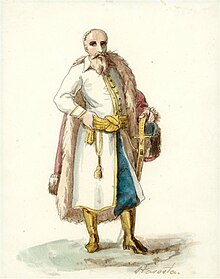Starostwo

This article needs additional citations for verification. (December 2009) |
Starostwo (Polish for "eldership", Template:Lang-be, Template:Lang-de), from the 14th century in the Polish Crown and later through the era of the joint state of Polish-Lithuanian Commonwealth until the partitions of Poland in 1795, referred to the crown lands (królewszczyzna) administered by the official known as starosta. The starosta would receive the office from the king and would keep it until the end of his life; it usually provided a significant income for the starosta.
His deputy was variously known as podstarosta, podstarości, burgrabia, włodarz, or surrogator.[1]
There were several types of starosta:
- Starosta Generalny was the administrative official of a specific territorial unit: either the representative of the King or Grand Duke or a person directly in charge.
- Starosta Grodowy was a county-(powiat-)level official responsible for fiscal duties, police and courts, and also the one responsible for the execution of judicial verdicts.
- Starosta Niegrodowy was the overseer of the Crown lands.
Between 1918 and 1939 and 1944–1950, the starosta was the head of county (powiat) administration, subordinate to the voivode. Since the local government reforms, which came into effect on 1 January 1999, the starosta is the head of the county (powiat) executive (zarząd powiatu), and the head of the county administration (starostwo powiatowe), being elected by the county council (rada powiatu).
